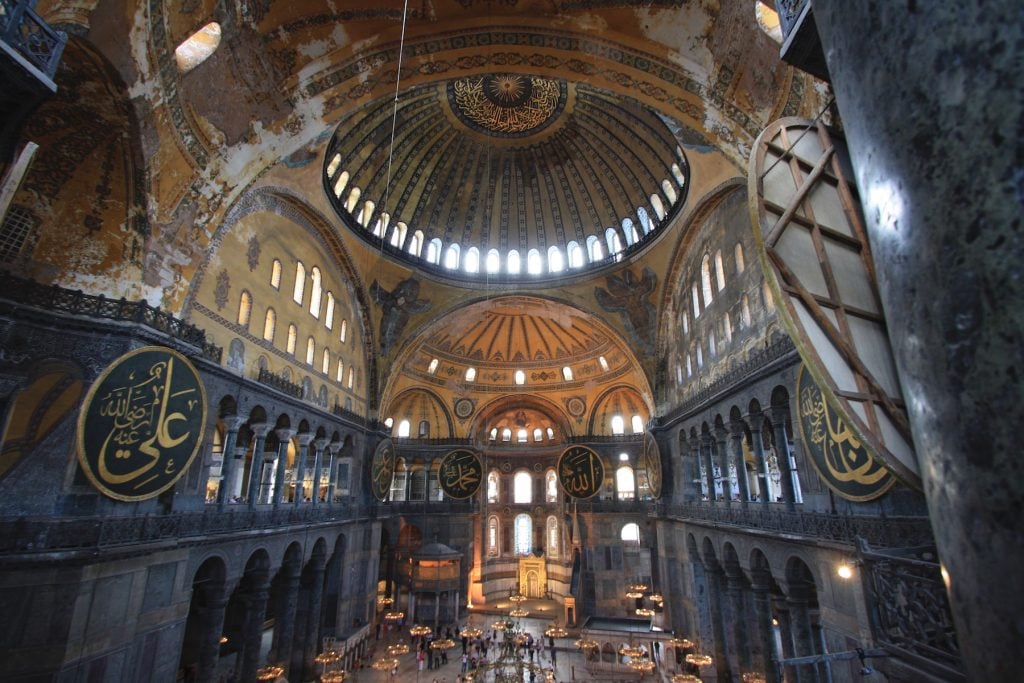A number of marble tiles on the floor of the Hagia Sophia in Istanbul, which was turned back into a mosque in 2020 after serving as a historical museum for decades, have reportedly been cracked by heavy machinery used to clean the building last week. According to the Turkish newspaper Cumhuriyet, a tour guide on the site said, “This historic building has faced tremendous damage. When Hagia Sophia was a museum, people visited it with great respect. It’s like a fairground now.”
The UNESCO World Heritage Site is considered to be one of the most important religious and cultural sites in the world, held in special regard by both Christians and Muslims alike. Built between 532 and 537 by the Eastern Roman Emperor Justinian I, when the city was known as Constantinople, it is one of the greatest examples of Byzantine-era architecture. It was initially the largest Christian cathedral in the world, but was converted into a mosque following the Fall of Constantinople to the Ottoman Empire in 1453. Turkish leader Mustafa Kemal Ataturk turned Hagia Sophia into a museum in 1935, declaring it be “open to the visits of all nations and religions.”
Its recent change in status from a museum back into a mosque sparked controversy across the heritage world. It also meant an administrative change too, since Hagia Sophia went from the control of the Department of Antiquities, which is part of the Ministry of Culture, to the Department of Religious Affairs.
Throughout the building’s long and storied history, countless relics and mosaics have been lost, stolen or damaged. Since its reconversion into a mosque, reports have surfaced documenting other forms of damage at the site, including to the Imperial Gate, which dates back to the sixth century. Known as the Door of Repentance, it contains an icon of Jesus alongside one of Mary of Egypt and the Theotokos, all of which were brought from the Holy Sepulcher in Jerusalem.
On 18 April 2022, a group called the Turkish Association of Art Historians documented vandalism to the 7-meter-tall gate, which the Byzantines claimed was constructed from oak beams taken directly from Noah’s Ark. In a Twitter post, the group showed gouges made deep into the wood and said: “We discovered that the historic Imperial Gate of Hagia Sophia is in such a state and we photographed it, around 20:45 tonight.”
The incidents have raised questions about how the site is being preserved since it was opened for regular religious worship. Marie-Eve Lafontaine, an art historian who studies medieval art and conservation practices, says that while the conservation of such a significant piece of architecture is never without difficulties, “it’s important to keep in mind that holy sites, whether church or mosque, have always been intended for daily use.”
She added that “as art historians and conservationists, we can only hope that visitors, religious or non-religious, treat the architecture with respect, as well as those governments which are entrusted with the care and keeping of tangible cultural heritage regardless of religious affiliation.”
Others are more critical of the Turkish government’s approach to Hagia Sophia’s upkeep. According to Arie Amaya-Akkermans, a classicist and fervent cultural commentator based in Istanbul, the reconversion of the building into a mosque is a symbol of contemporary Turkey, “where heritage of the ‘other’ is destroyed and plundered in broad daylight to make way for uncontrolled development or simply for the pleasure of vandalism.”
In an earlier tweet showing a Minnie Mouse balloon floating next to the historic mosaics on building’s ceilings, Amaya-Akkermans recently speculated that the carnivalesque atmosphere around the Hagia Sophia has ultimately led to its dedication to a more familiar deity.
“The imagery on social media is terrifying,” Amaya-Akkermans told Artnet News. “The crowds, food packages strewn across the floor, people chipping parts of the walls, and now the cracked floors. What’s the take out of this? Selective heritage policy almost entirely as a vehicle of propaganda.”






